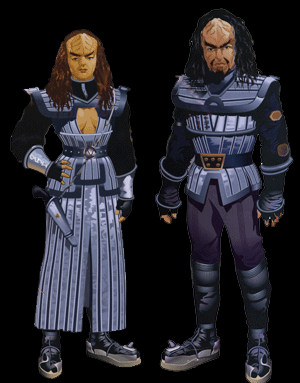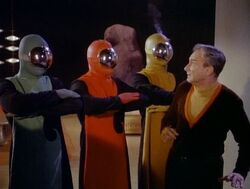
Klingons are a well-known example of a humanoid species.
- "Amy Pond: You look human.
The Doctor: No, you look Time Lord. We came first." - ―Doctor Who, "The Beast Below" (2010).
The word humanoid denotes any lifeform, either natural or artificial, which has a body plan similar to that of a Human being or which shares enough common characteristics with Humans, as of external appearance, to be considered similar, if only on a superficial level.
Definition[]
The definitions of the term vary widely among science fiction authors and enthusiasts. Typically, the basic requirements for a species to be classified as humanoid are: bilateral symmetry; an erect bipedal posture in which the body is supported by two legs; a pair of arms protruding from the upper side of the body and ending on manipulatory organs (hands); and a head supported on the top of the body, where the mouth and most sensory organs are usually placed.
In the straightest definitions, a humanoid species must also have roughly Human-like proportions, thus excluding those with extremely long, slender limbs and a small body, for example. On the other hand there are broader definitions in which small deviations from the Human-like body plan (e.g. four arms, a tail, etc.) may be acceptable.
There are cases in which it is difficult to decide on whether a given alien species is humanoid or not. Vogons, for example, fulfill all the basic requirements listed above, but have a much bulkier and rounded body, which makes them hard to be classified as humanoids. The Sarrians from Hal Clement's novel Iceworld have a relatively humanoid body, but their legs have three joints and they have four long tentacles in place of humanoid arms.
Other classifications[]
Other common ways of classifying alien lifeforms, such as "reptilianoids", "mammalianoids" or "insectoids", are not opposed to the humanoid concept, making it possible for a species to be both humanoid and reptilianoid, for example. The Gorn and the Prawns may provide excellent examples of reptilianoid-humanoids and insectoid-humanoids, respectively. Since Humans are mammals, the distinction between mammalianoid humanoids and plain mammalianoids is harder to pinpoint. Mammalianoid species with typically mammalian, but not Human, traits, such as fur covering, a well-developed snout or long tail, may or may not be considered humanoid depending on their overall body plan (whether they are upright bipeds or not) and the author's judgment. An example of such lifeforms would be the Melmacians. It is imperative to note that there are species which are undoubtedly mammalianoid but not humanoid, especially quadruped or cetacean-like species.
Real world examples[]
Among the few real world animals which can be described as humanoids are gorillas and the other great apes. If bears were fully bipedal and not facultative bipeds, they would also provide a nice example of a humanoid creature. Humanoid robots (sometimes called androids and gynoids) have also been built in real life.
In ufology, many alien races also have a humanoid appearance, including Greys, Reptoids, Venusians and Martians. Many cryptids are also described as having a somewhat humanoid appearance, the most famous of all being the Bigfoot and the Yeti.
Science fiction[]

Dr. Smith confronted by humanoid robots from the Kingdom of Cybernetics.
In science fiction, humanoid species are a remarkably popular concept because they offer two grand advantages to the producers: they require little special effects (only make-up in most cases), and they are easier for the public at large to relate with. It is important to note that literature, a medium for which these advantages mean little, still has an enormous array of humanoid species. One could blame anthropocentrism, a desire to make the aliens more approachable to the Human characters and audience, or even a lack of creativity; but there are also those who argue that a humanoid body plan is the most adequate one for an intelligent species to evolve, because it allows for agility, dexterous manipulation of tools and an increase in brain size. There is, however, very little evidence that the humanoid body plan - efficient as it may be - would be particularly more efficient that any other body plan that could potentially evolve on an alien world.
In the particular case of artificial life, such as robots, it is assumed that one reason why so many of them are humanoid is that they were built by Humans or by another humanoid race. Also, many shapeshifting, amorphous or non-corporeal species in science-fiction often assume a humanoid shape in order to communicate more easily with humanoid species. Examples of this phenomenon include the Changelings and the Q.

The founding races of the Federation are all humanoid.
Sometimes, science fiction works will offer a plausible explanation for the existence of so many similar lifeforms evolving in different worlds, such as a humanoid common ancestor, or simply an ancient, highly advanced race credited with creating humanoids, including Humans, whether in their image or otherwise. In Star Trek, for example, the explanation resides in an unnamed, long-extinct Progenitor species which lived 5 billions of years ago. After exploring the galaxy for millennia, they were disappointed to find no other species similar to themselves and decided to spread DNA molecules through several planets, encoding a program in these molecules for them to be incorporated by local life and guide their evolution until they evolve into a humanoid species.
In the Doctor Who audio story "Zagreus", a very similar explanation is given, but replacing the unnamed species with Time Lords. A Doctor Who novel called "Lucifer Rising" offers a variation of the story, in which the Time Lords were the first sapient race to evolve in the universe, and their arrival generated a "morphic field" which made the emergence of humanoid intelligences much more likely.
Another common explanation for humanoid aliens is the idea that these are evolutionary relatives or offshoots of Humans. This idea is widely used in the Stargate saga, for example. It is also used in the Dune novels.
One interesting curiosity is that, while sapient species in science fiction commonly have a humanoid external appearance, examples of non-sapient humanoid creatures are considerably harder to come across. One possible example would be the Xenomorphs, although their eyeless, elongated head, long tail and the fact that they only occasionally walk erect would make them semi-humanoid at best. Plus, Xenomorphs retain a fairly humanoid appearance only as long as they are formed from a humanoid host.
It is common for humanoid species to be genetically compatible with Humans, producing hybrid offspring. This is particularly common in the Star Trek franchise, with Mr. Spock, a half-Vulcan half-Human hybrid, being the most well-known example.
In the Sector General book series by James White, humanoid species are given the physiological classification DBDG.
Notable humanoids[]
For a complete list of humanoid races, go to Category:Humanoids
| This section is still incomplete. You can help Alien Species Wiki by adding the information that's missing. |
|---|
Doctor Who Universe
- Adipose
- Cybermen
- Draconian
- Humans
- Kaleds
- Ood
- Raxacoricofallapatorians
- Sensorites
- Sontarans
- Thals
- Time Lords
Star Trek Universe
- Progenitors
- Augments
- Andorians
- Bajorans
- Betazoids
- Bolians
- Borg
- Breen
- Cardassians
- Changelings (when interacting with humanoids)
- Ferengi
- Gorn
- Humans
- Jem'Hadar
- Klingons
- Orion
- Nausicaans
- Romulans
- Suliban
- Talosians
- Tellarite
- Vorta
- Vulcans
- Xindi (excluding aquatics and insectoids)
Star Wars Universe
Stargate Universe
Dragon Ball Universe
Others
- Aliens (Fire in the Sky)
- Aliens (Plan 9 from Outer Space)
- Arriani
- Brodo Asogians
- Cherubs (Homestuck)
- Dracs
- Enlil
- Greys
- Humanoid Aliens (The Twilight Zone)
- Junglins
- Kanamits
- Kryptonians
- Mark Zuckerberg
- Martians (sometimes)
- Na'vi
- Pearls
- Outlanders
- Remulakians
- Reptoids
- The Ambassador's species
- Trolls (Homestuck)
- Venusians (sometimes)
- Yautja
- Zornox